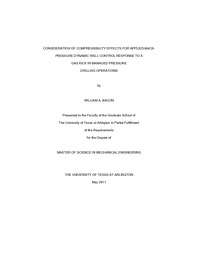
ATTENTION: The works hosted here are being migrated to a new repository that will consolidate resources, improve discoverability, and better show UTA's research impact on the global community. We will update authors as the migration progresses. Please see MavMatrix for more information.
Show simple item record
| dc.contributor.author | Bacon, William Alexander | en_US |
| dc.date.accessioned | 2011-07-14T20:48:10Z | |
| dc.date.available | 2011-07-14T20:48:10Z | |
| dc.date.issued | 2011-07-14 | |
| dc.date.submitted | January 2011 | en_US |
| dc.identifier.other | DISS-11088 | en_US |
| dc.identifier.uri | http://hdl.handle.net/10106/5630 | |
| dc.description.abstract | Managed Pressure Drilling (MPD) operations offer the ability to control a relatively small gas kick dynamically, without shutting in the well using blowout preventers. One currently employed method of dynamic well control uses applied-back-pressure to force flow exiting the wellbore to equal flow entering the drill-pipe, which is taken as an indication that the influx has stopped. However, for flow out equals flow in to imply influx cessation, the assumption of incompressibility of fluid in the wellbore is necessary. When fluid compressibility is appreciable, solely ensuring flow rate continuity does not necessarily imply influx cessation. The period of "dynamic well control" in an MPD operation- from the moment an influx is identified until the moment the influx is believed to have ceased- is examined in this work. A control volume mass balance with compressibility is used to analyze the system. This approach enables inclusion in flow calculations of the expansion or compression of in-situ influx gas within the wellbore. Since cessation of influx is the primary goal of dynamic well control, this work examines the transient, multiphase flow behavior in the annulus to explore limitations of the existing applied-back-pressure, dynamic, well control technique. It is shown that with the existing method, influx cessation does not always occur once flow out is constrained to equal flow in. It is also shown that in some situations where influx cessation is indeed achieved when flow out equals flow in, the back pressure applied at surface is higher than required to achieve influx cessation- i.e., influx ceases before the moment when flow out equals flow in. These outcomes are the consequence of the compressibility of the in-situ gas, and make the existing method unreliable in some critical situations of influx. A new applied-back-pressure, dynamic well control technique has been proposed, and a transient, multiphase flow analysis is used to identify pressure-based indicators of influx cessation. It is shown that time derivatives of pressure and pressure transfer carry the signature of well response for the given control strategy, and can be used to infer cessation of influx. It is argued that, taken together, these are more reliable indicators of influx cessation (and hence successful well control) than solely ensuring flow out equals flow in. Numerous transient, multiphase flow simulations have been conducted to support the key conclusions of this work. | en_US |
| dc.description.sponsorship | Tong, Albert Y. | en_US |
| dc.language.iso | en | en_US |
| dc.publisher | Mechanical Engineering | en_US |
| dc.title | Consideration Of Compressibility Effects For Applied-back-pressure Dynamic Well Control Response To A Gas Kick In Managed Pressure Drilling Operations | en_US |
| dc.type | M.S. | en_US |
| dc.contributor.committeeChair | Tong, Albert Y. | en_US |
| dc.degree.department | Mechanical Engineering | en_US |
| dc.degree.discipline | Mechanical Engineering | en_US |
| dc.degree.grantor | University of Texas at Arlington | en_US |
| dc.degree.level | masters | en_US |
| dc.degree.name | M.S. | en_US |
Files in this item
- Name:
- Bacon_uta_2502M_11088.pdf
- Size:
- 3.744Mb
- Format:
- PDF
This item appears in the following Collection(s)
Show simple item record


